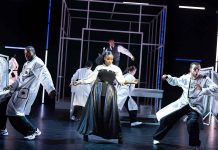
A crowd of dance theatre lovers gathered at Sadler’s Wells to witness NDT and Complicité’s production of Figures in Extinction: a stellar programme of dance, theatre, spoken word and music. The work evolved over three sections, addressing the human condition and its impact on the natural world.
An ensemble of mannequin-like performers in black trousers and white vests, opened part (1.0) The List.
Gesticulating to a voiceover to communicate the plight of animals in decline; the dancers’ staccato movements and intricate portrayals set the epic tone for an exceptionally moving evening. A performer displaying massive tusks on both arms, carved ritualistically through the space, their undulating spine capturing images of a prehistoric animal, through sensuous and detailed movement. The effect was reminiscent of the DNA Double Helix. The explicit use of DNA was a connective theme threaded throughout all three works.
Complicite’s Simon McBurney and choreographer Crystal Pite adeptly brought the climate change disaster to the forefront of our minds. The extinction of our flora and fauna was spelt out in encyclopaedic vignettes; through the use of documentary footage, spoken word, arresting statistics, and expertly executed by the exquisite NDT dancers. Dancers who were as dynamically precise as they were mercurial. Their use of contact, breath and control was exemplified by Pite’s bold, raw and visceral choreography.
In juxtaposition to the exploration of species being culled from the ecosystem, we were subjected to a Trumpian tirade, from a climate change denier. Like an unhinged puppet on speed, the performer took the audience down a literal rabbit hole of misinformation, disguised as a larger than life, cabaret, game show.
This first section was breathtaking in its use of striking scenography, impactful lighting, primal soundscapes and skilful puppetry, which felt like I had just stepped into the Natural History Museum. Through a litany of times and dates, the extinction of our wildlife was projected both visually and aurally, provoking action to prevent more of our environment being eroded. It was a poignant section which asked the question: what will we leave for future generations?
Part (2.0) But Then You Come to the Humans: a quirky, explosive section which explored the brain’s hemispheres; its control on our behaviour, and how the rise of social media and technology has co-opted the brain – effecting how we cope with everyday tasks, emotional events and interpersonal relationships. Seated performers in muted, business attire, on their daily commute – phones in hand, doom scrolling, consuming trivia, sporting statistics, gossip, wellbeing mantras, and cooking tips.
The vocabulary grew from pedestrian to expansive unisons, which highlighted Pite’s signature devices of push, pull, tension and release. McBurney and Pite’s well integrated collaboration captured our chaotic and schizophrenic internal and external lives. This was achieved through humorous medical voiceovers, sophisticated sonic frequencies, impeccable manipulations of props and agilely sculptural movement.
The Chorus Line style opening to part (3.0) Requiem was deeply personal and examined dying and death, what and who is left behind and our metaphysical connection to our family members, that have passed and made the transition to ancestorial realms. The storytelling in the section was both palpable and committed. Invested, I followed the dancers relaying information about their birthplace, home and their family. This segued into a hospital scene equipped with an IV bag, heart monitor and disgruntled nurses.
The audience witnessed the tragic repercussions of death on family members and loved ones. Although the section was coherent and a natural follow on from (2.0), it could have been shortened, as some of the material used in earlier sections was overly replicated.
Figures in Extinction is a mammoth of a production, the creative team and performers should be extremely proud of their achievement, as they have produced a groundbreaking and thought provoking piece of theatre. This production does what great art has the ability to do: entertain, educate, inform, question, challenge, provoke debate and call for action.


























